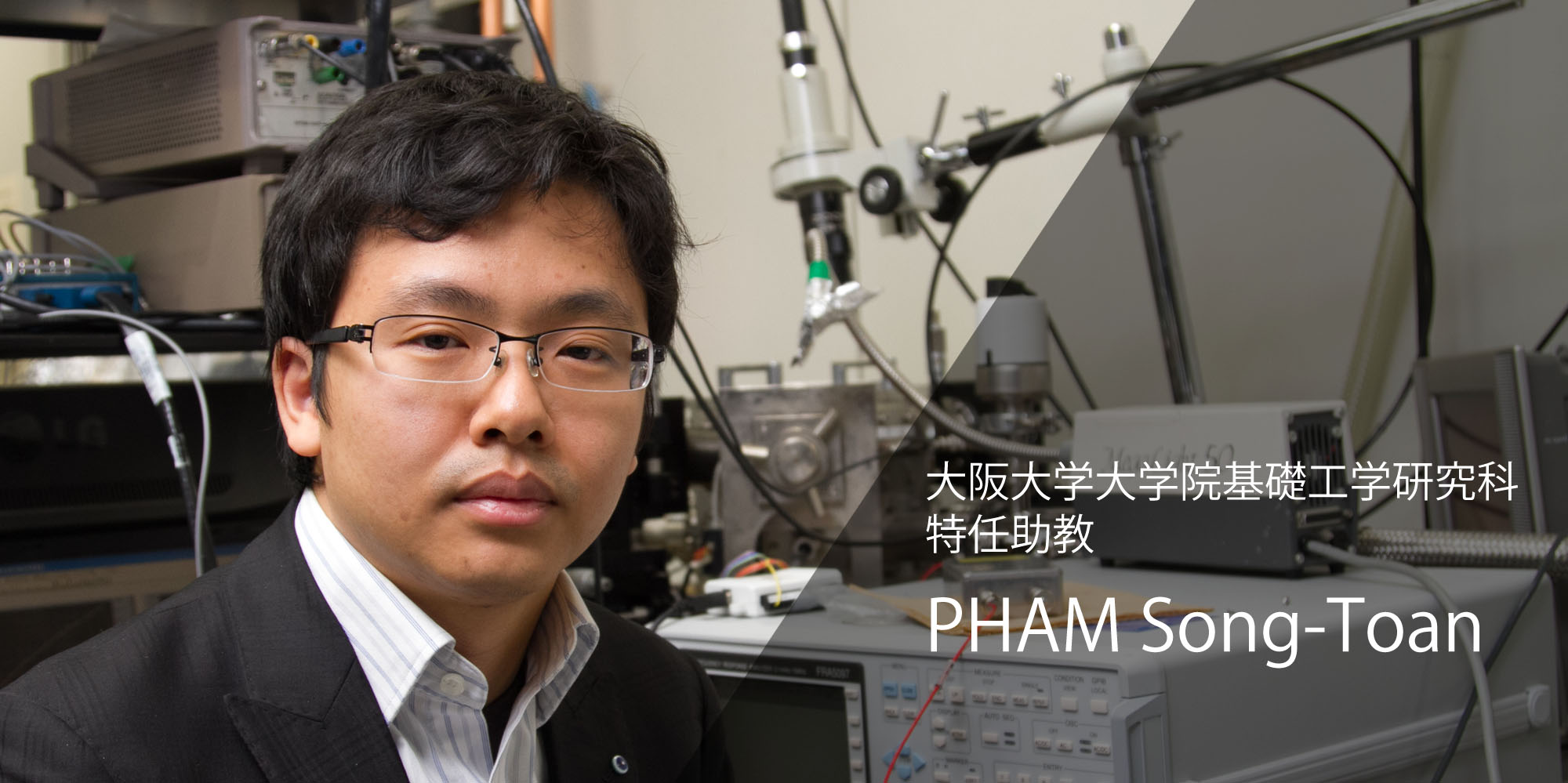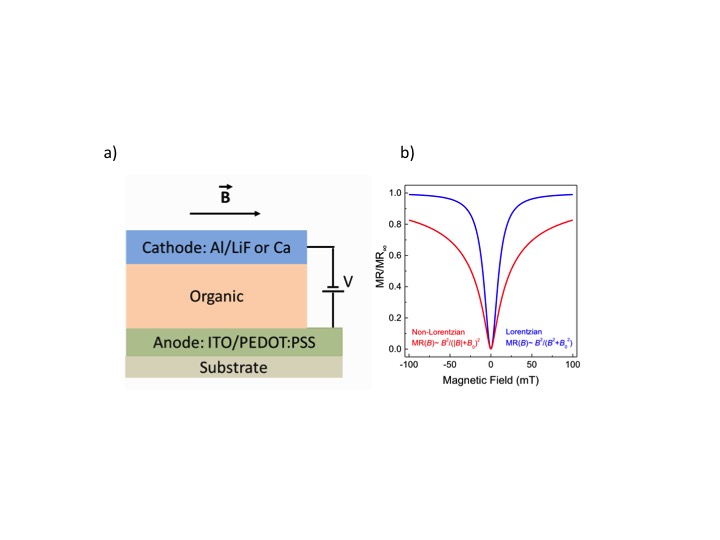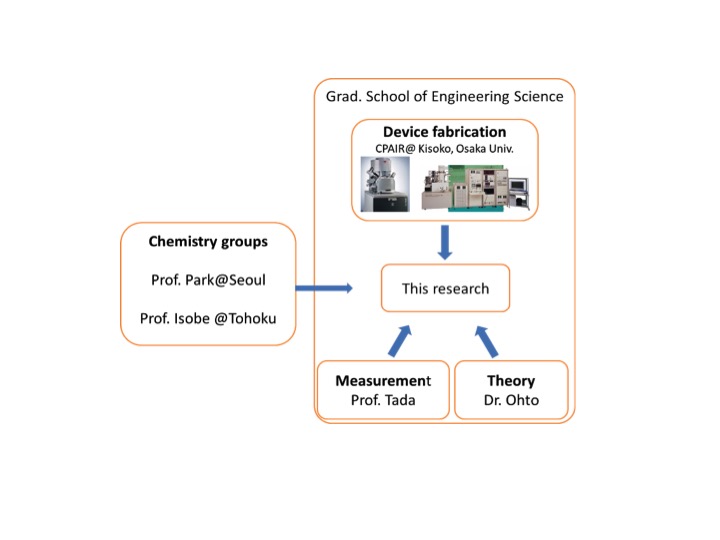
Invitation to organic magnetoresistance: An interface between two limelight fields
Basic research in organic semiconductor will definitely lead to the development of next generation electronics such as organic light emitting TV. Here, I would like to introduce my research on the magnetic field effect of organic semiconductor. It is the effect observed in organic semiconductor, but the mechanism is yet unveiled. We believe that a deeper understanding of this effect will show how organic semiconductor be applied to spintronics. Hope you can see the possibility of my research for future collaboration.
OMAR rises, yet its mechanism under controversy
Have you ever heard the word, “organic magnetoresistance (OMAR)”? In this decade, it has been attracted a great scientific interest because of its enigmatic phenomena with high potential for industrial applications. External magnetic field causes a change in the current driven through an organic layer (Figure 1). This change of the current can be up to 10% under small magnetic field (~10mT) at room temperature. These properties may make OMAR become an important effect for future application to various industries; such as development of next generation memory, magnetic field sensor1 or magnetic-optic transducer2… Besides, this effect can be used as an investigation/detection technique to study special effects in organic solar cell, organic light emitting diode… Deeper understanding of these effects contributes to spintronics field. Thus, revealing OMAR mechanism is attractive not only in the viewpoint of fundamental science but also in the applications to the industries.

Figure 1:(a) Common device structure for observing OMAR. (b) typical magneto-resistance curves. Change of the current is observed in various materials from small molecules (pentacene, Alq3) to polymers.
Up to now, scientists around the world have studied various organic materials and proposed numerous mechanisms to elucidate OMAR effect. However, it is still under controversy mostly due to lack of analyzing technique and unstable nature of organic device.
Novel device set up for investigating OMAR mechanism

One of the keys to understand OMAR is to develop new technique, which can investigate the multi-processes occurred at the same time in device. To overcome above difficulties, we employed two experimental methods in our set up, which are impendence spectroscopy and spectral resolve of magneto-electroluminescence (MEL). First, impedance spectroscopy is helpful for understanding the electronics transport and how trap interactions at the interface may affect OMAR. In this set up, we found that the dominant OMAR mechanism could be easily identified. Second, electroluminescence from the device shows broad range spectra, which derives from the recombination of singlet/triplet excitons and exciplexes with a wide range of binding energies. Simply saying, by observing a variety of luminescent signals as output, we can diagnose the alignment of spin inside the device. These results show that our set up could be an excellent tool to investigate organic spintronics.
Waiting the collaboration for future applications
By employing these innovative techniques, it is expected that the detailed electronic process (charge injection, trap interactions) and singlet/triplet states recombination/conversions effect under magnetic field of organic devices can be profoundly understood in our study. To further understand the mechanism, we have already established the collaborative team (Figure 2). Organic molecules which have special characters will be designed and synthesized in the collaborator’s lab. By using characteristic materials such as ambipolar, large charge transfer, and high phosphorescence/fluorescence efficiency, various aspects of OMAR can be revealed.

Figure 2: This project will collaborate with chemical groups of Prof. Park (at SNU, Korea) and Prof. Isobe (at AIMR, Tohoku University), where will design and synthesize advance molecule. The device fabrications and measurements can be done in Graduate School of Engineering Science at C-PAIR and group of Prof. Tada.
We believe that our collaborative effort will not only understand OMAR mechanism, but also help the field more applicable to organic spintronics. Since various organic materials are used in solar panel, and specific OMAR effect should be observed in it, we seek collaboration partners in the solar panel industry. By study the magnetic field effect in solar panel, we may know the cue for the breakthrough of the energy efficiency. Also, I have started thinking that we can discuss with biologists. I heard that the birds somehow feel magnetic field, and I imagine OMAR is involved in this phenomenon. From the engineering viewpoint, we can contribute to biology, too. OMAR is still in its infancy; so, we are open to any field for collaboration to apply our knowledge.
References
- Baker, W. J. et al. Robust absolute magnetometry with organic thin-film devices. Nat. Commun. 3, 898, 2012.
- Macià, F. et al. Organic magnetoelectroluminescence for room temperature transduction between magnetic and optical information. Nat. Commun. 5, 3609, 2014.
- Francis, T. L., Mermer, Ö., Veeraraghavan, G. & Wohlgenannt, M. Large magnetoresistance at room temperature in semiconducting polymer sandwich devices. New J. Phys. 6, 185, 2004.
研究室HP
主要論文
- Pham, S.-T. & Tada, H.* Magnetoluminescence of light-emitting field-effect transistors based on alpha sexithiophene. Appl. Phys. Lett. 104, 133301 (2014).
- Pham, S.-T., Kawasugi, Y. & Tada, H.* Organic magnetoresistance in ambipolar field- effect transistors. Appl. Phys. Lett. 103, 143301 (2013).
- Thuy, U. T. D., Pham, S.-T., Chi, T. T. K., Khang, D. D. & Liem, N. Q.* CdTe Quantum Dots for Application in Life Science. Adv. Nat. Sci. Nanosci. Nanotechnol. 1, 045009 (2010).
